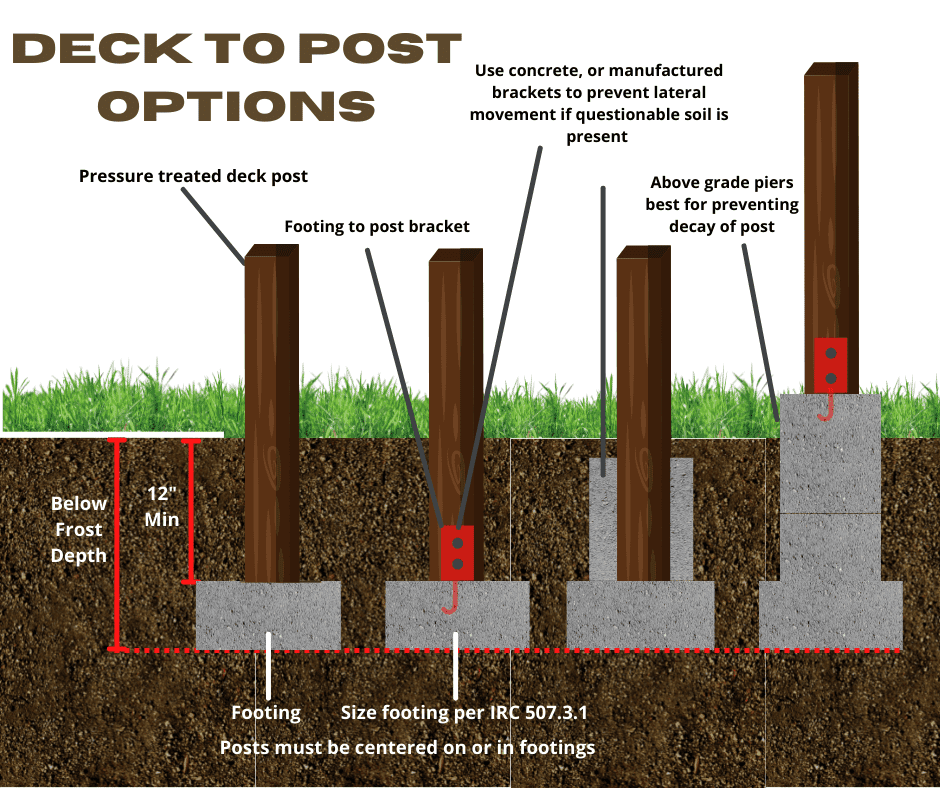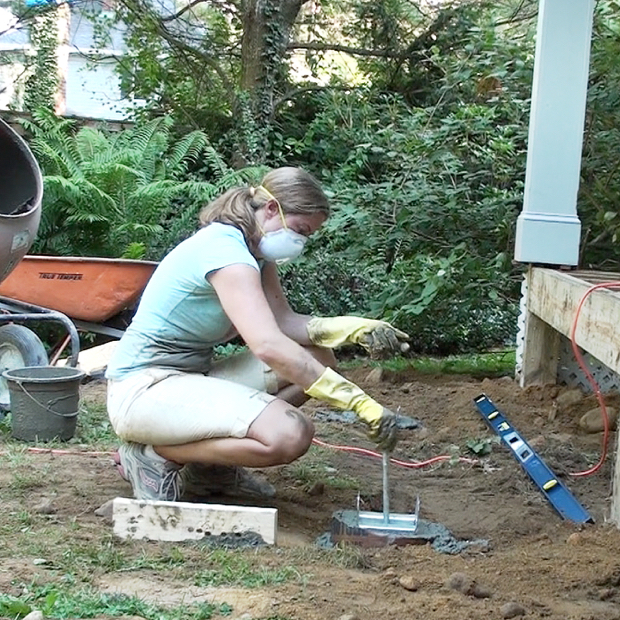Make Certain Stability and Long Life With Properly Set Up Deck Grounds
Deck grounds may not be the most glamorous aspect of deck building, however they play an important role in making certain security and durability. In this discussion, we will certainly check out the significance of appropriate deck footings, factors to consider throughout setup, various kinds of footings readily available, detailed installation overview, and upkeep ideas for making certain resilient footings.

Value of Correct Deck Footings
Why are correctly set up deck footings crucial for the stability and long life of your deck? Deck grounds are the foundation on which the deck rests, moving the tons from the deck to the ground.
Firstly, properly mounted deck grounds distribute the weight of the deck equally, protecting against any kind of unequal settling or sinking. This is especially important in locations with unsteady soil, as it assists to mitigate the threat of the deck collapsing or changing. In addition, well-installed footings guarantee that the deck remains degree, avoiding any architectural damages that can occur when a deck becomes irregular.
Second of all, correctly installed grounds offer a strong anchor for the deck, preventing too much motion and guide. This assists to maintain the architectural stability of the deck, decreasing the threat of mishaps or injuries. It likewise minimizes the deterioration on the deck, allowing it to hold up against the elements and normal use for a longer time period.
Aspects to Consider for Deck Footing Installment
When setting up deck grounds, there are several crucial factors to think about for proper installment. These factors can substantially influence the security and longevity of your deck. First and primary, you require to identify the kind of dirt on which the deck will be constructed. Various dirt types have different load-bearing abilities, so it is important to perform a dirt test to guarantee the grounds can sustain the weight of the deck and its occupants. Additionally, the place and format of the deck need to be thoroughly intended to stay clear of any obstacles such as trees, utility lines, or underground pipelines. It is additionally crucial to take into consideration the neighborhood environment and climate condition, as these can impact the longevity of the grounds. As an example, areas with a high water table might require additional steps to avoid water damage. Last but not least, the dimension and product of the grounds need to be chosen based on the size and weight of the deck, as well as the local building ordinance and regulations. By thinking about these elements, you can ensure the proper installment of deck grounds and take pleasure in a long-lasting and stable deck.
Sorts Of Deck Footings to Select From
There are several different types of deck grounds available for you to select from. Each kind has its own advantages and negative aspects, so it's necessary to consider your details requirements and the problems of your deck before choosing.
One common kind of deck ground is the concrete footing. This involves excavating openings in the ground and pouring concrete into them to develop a strong foundation. Concrete footings are resilient and supply exceptional security, making them appropriate for decks in areas with tough dirt conditions or high wind lots.
One more choice is the helical pier footing, which is composed of a steel shaft with helical plates that are screwed right into the ground. These footings fast to set up and can be used in numerous soil kinds, consisting of sandy or clay soils. They are additionally adjustable, allowing for very easy leveling of the deck.
Sonotube grounds are one more preferred option. These grounds are produced by placing a cardboard tube in an opening and filling it with concrete. Sonotube grounds are relatively very easy to install and give sufficient security for smaller decks or in locations with less requiring soil problems.

When selecting the type of deck footing, it's important to think about aspects such as soil conditions, deck size and weight, local building regulations, and individual choices. By choosing the proper footing type, you can ensure the security and long life of your deck.
Step-by-Step Overview for Setting Up Deck Footings

Establish the location: Begin by noting the specific position of each ground making use of stakes and string (Deck Footings). Take into consideration any kind of neighborhood building codes or policies pertaining to setback distances
Dig the holes: Make use of a blog post hole digger or an auger to dig the holes for the grounds. The deepness will certainly rely on the frost line in your area and the type of soil. Normally, a deepness of at the very least 36 inches is advised for security.
Degree the openings: Make sure that all-time lows of the openings are degree (Deck Footings). This can be attained by making use of a degree or a straight board throughout the top of the openings
Include crushed rock: Area a layer of crushed rock at the end of each opening to enhance drain and stop the ground from penetrating the soil gradually.
Place the footing forms: Insert the footing forms right into the openings, guaranteeing they are centered and level. Use risks to safeguard them in position.
Mix and put concrete: Follow the directions on the concrete mix bag to prepare the concrete. Put the concrete right into the ground types, filling them completely.
Smooth the surface: Make use of a trowel to smooth the surface area of the concrete and eliminate any type of air pockets. Allow the concrete to heal according to the supplier's guidelines.
Upkeep Tips for Lasting Deck Footings
Proper upkeep is essential for making certain the durability and security of deck footings. By on a regular basis examining and keeping your deck footings, go to my site you can stop damages and potential security hazards.
Routine cleansing is also necessary for maintaining deck footings. Plant life, dirt, and particles can collect around the grounds, which can result in moisture accumulation and decay. Cleaning up the footings consistently, making use of a pressure or a brush washer, can help stop these issues and find out here prolong the life-span of your deck.
In enhancement to cleaning, it is crucial to keep the area around the grounds clear of any blockages. Prevent piling things against the grounds or allowing plants to expand also close to them. These blockages can trap wetness and trigger the footings to degrade gradually.
Last but not least, normal resealing of the grounds is suggested to safeguard them from wetness and other environmental elements. Applying a waterproof sealant can help prevent water damages and expand the life-span of the grounds.
Final Thought
To conclude, appropriate setup of deck footings is essential for guaranteeing stability and long life of your deck. Elements such as soil kind, lots capability, and regional building regulations need to be taken into consideration when selecting the best kind of deck grounds. Adhering to a step-by-step guide for installment and routine upkeep will certainly assist to make sure the footings stay resilient and durable.
In this discussion, we will check out the relevance of proper deck grounds, aspects to think about during setup, different kinds of footings readily available, detailed installation overview, and maintenance ideas for making sure long-lasting grounds. Deck footings are the structure on which the deck rests, moving the load from the deck to the ground.One typical type of deck ground is the concrete footing. Place the ground types: Put the footing forms into the holes, ensuring they are centered and degree.In final thought, appropriate installment site of deck footings is crucial for making sure stability and durability of your deck.